The best BBQ Delivery Boxes in the UK from small sustainable British Farms
“Out beyond ideas of wrongdoing and rightdoing, there is a field. I’ll meet you there.”
– Rumi.
First there was Veganuary, a campaign that encourages people to go vegan for the month of January, in the hope they’ll switch to a more plant-based diet more permanently. Then came Regenuary, a movement that encourages people to source their food from regenerative farms, for the month instead. Farms that have a low carbon impact or even positive impact production methods for all food – meat included.
But, veganism and regenerative agriculture have roots that go far deeper than these two campaigns. While the ideologies are pitted against one another, at their core lies mutual territory: both are calling for a better food system.
This common ground too often gets lost in the debate. Both vegans and meat eaters are each determined to prove their choices ‘right’ and the others ‘wrong’.
But, many in farming know the answers aren’t quite so easily defined as that.
So, we decided to bring a vegan farmer and a regenerative farmer together for a kitchen table discussion. The goal was explicit from the outset: to challenge the reductive binaries and instead find points of overlap that will help us to move towards healthier food, produced in tune with nature…
The vegan farmer and the
regenerative farmer…
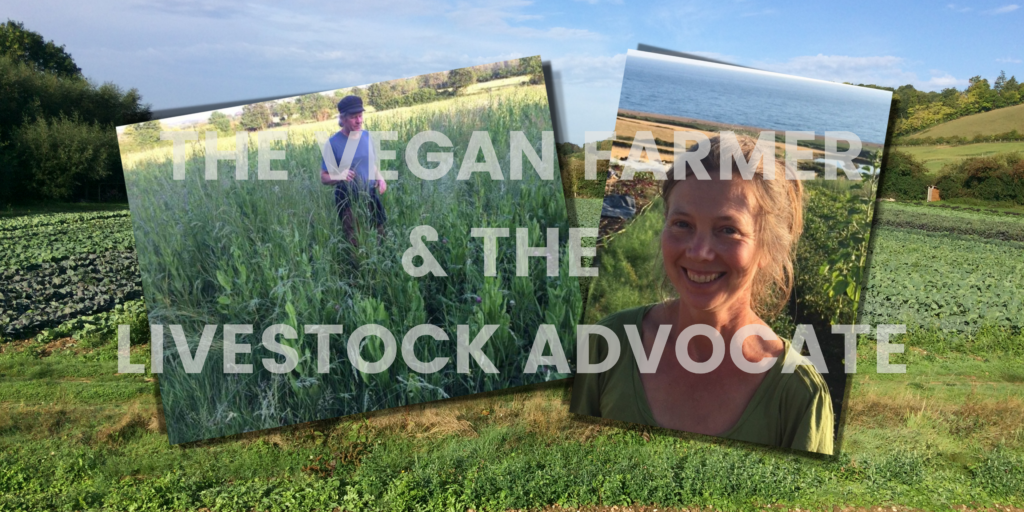
The vegan regenerative farmer:
Iain Tolhurst (Tolly)
Iain Tolhurst (Tolly) has been an organic vegan farmer for more than 45 years. Tolhurst Organic farm has been certified stock-free organic (they don’t use animals or animal products in their farming) for 20 years.
The regenerative farmer and livestock advocate:
Rebecca Laughton (Bee)
Rebecca Laughton (Bee) has an MSc in sustainable agriculture. She is author of Surviving and Thriving on the Land. And she works with the Landworkers Alliance – a union of land-based workers with a mission to create a better food and land-use system for everyone. Bee has experience of variety of farms that produce meat, fruit and vegetables in the UK, France and the US.
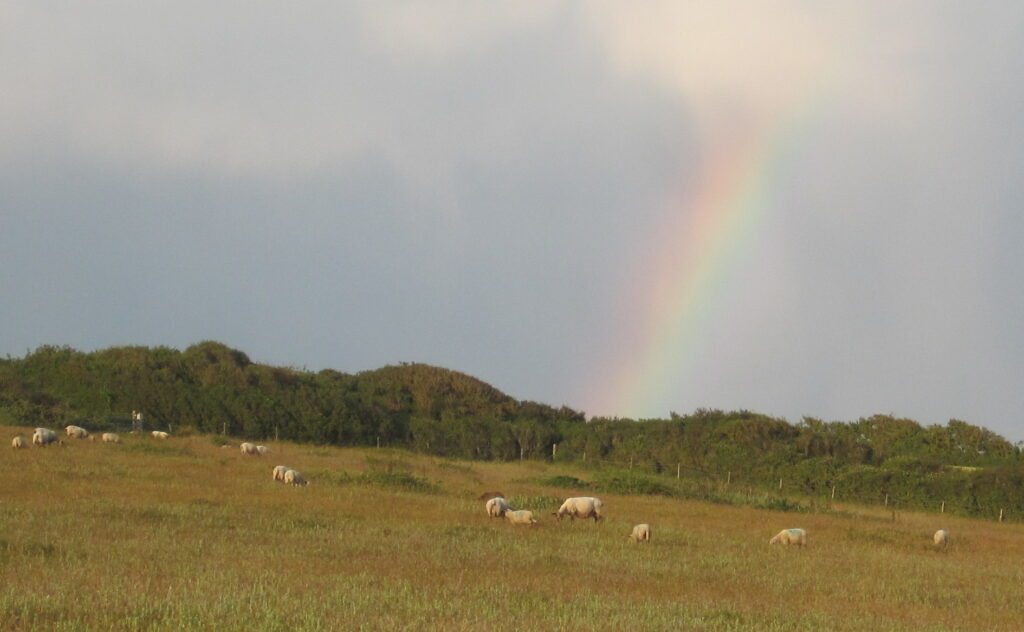
Regenerative Agriculture:
the case for livestock?
“I’ve really seen the benefits of managing really biodiverse, rich grassland with livestock,” says Bee, kicking off the conversation.
It was Bee’s experience at Tamarisk organic farm, a mixed family farm managing around 600 acres of land on Dorset’s Jurassic Coast, that really cemented this belief for her.
The family at Tamarisk grows vegetables, fruit, wheat, rye, barley and oats and peas in an effort to provide the majority of dietary needs from the land. This mean they are not totally reliant on livestock.
But, cattle and sheep most effectively manage much of the land. So, they also have a herd of breeding stock (25 Red Devon cattle) and about 200 ewes. The biodiversity here is ‘astonishing’ according to Bee, the total number of flowering plant species is at least 200, not including grasses, shrubs, lichens and other plants.
“For me, the whole vegan vs regen matter comes down to, would it be sensible to cultivate all of that land for growing arable crops or is the biodiversity better managed with animals?” she asks.
We’re off to a good start – Tolly doesn’t disagree.
He knows Tamarisk Farm well and recognises there is a case for livestock there, because the land isn’t ploughable. But, he asserts at his own farm, Tolhurst Organic, they also have 75 species of wild flowers and plants within their very intensive horticultural livestock-free unit.
So, he argues, it’s possible to have biodiversity and stock-free at the same time.
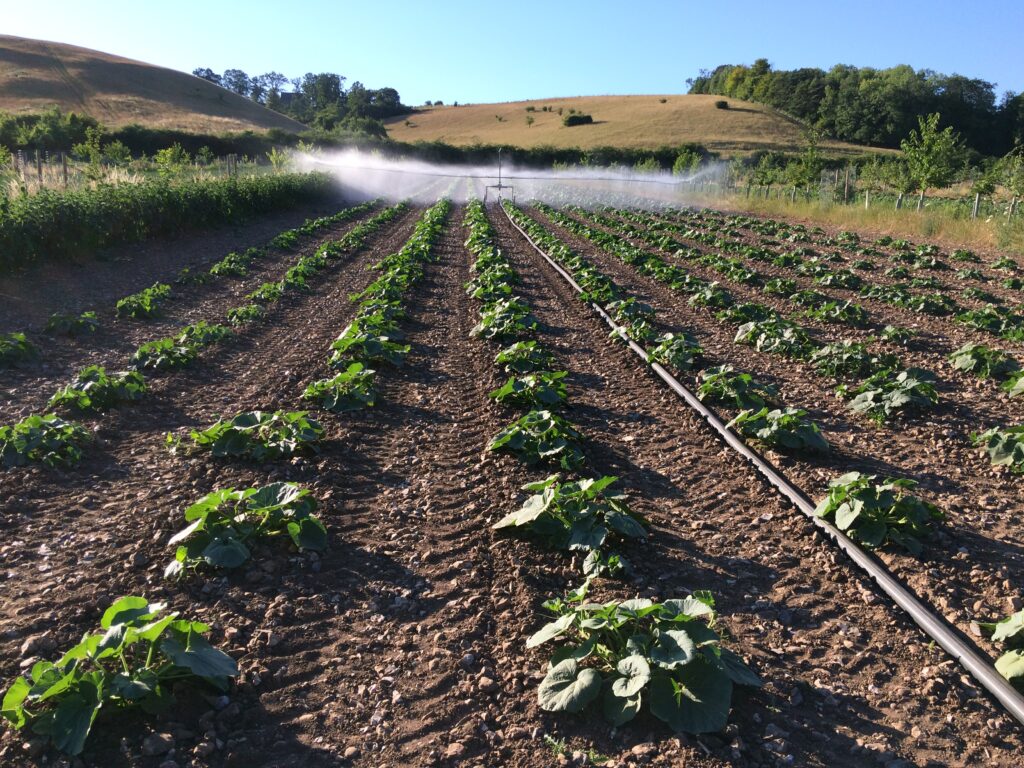
Regenerative Agriculture:
a vision for the future
“Rather than look at each farm, we need to look at the much larger picture. As a vegan-ish person I’m not so naive as to think everyone’s going to give up meat tomorrow. But, I think everyone agrees we have to reduce livestock production,” Tolly says.
“This would release a lot more land – for horticulture; to grow cereals for humans rather than animal feed; to grow hemp products for building materials and textiles; and for reforestation.”
Bee shares a similar vision:
“In my ideal land management system of the future, I’d be encouraging every farm – where appropriate – to have a proportion given over to horticulture. Because, I completely agree we need so much more fruit and vegetables to meet our national needs.
“Intensive and industrial livestock farming that relies on monocultures, feed grown specifically for animal feed, high levels of disease-preventing medication and keeping animals in unnatural conditions – I would be happy to see that go. There is no place in a civilised country for factory farming.
“Where I would argue there is a case for keeping livestock – cattle and sheep and ponies – is for conservation grazing. Also on mixed farms, where the livestock have a role in the rotation. And where domestic livestock, such as hens or pigs, can make use of food waste and byproducts.”
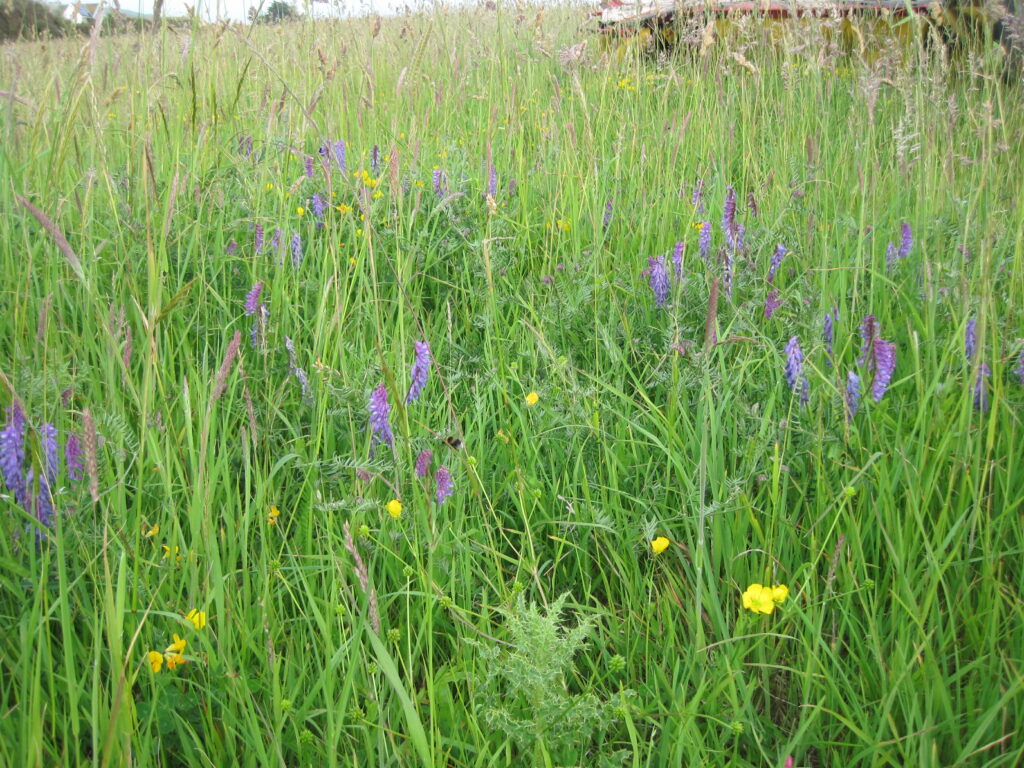
Arable Farming in the East vs Livestock farming in the West
In the UK there has been almost a physical divide in farming over the past 50 years. As seen in the shift to livestock farming in the ‘wet West’ and arable farming in the ‘dry East’.
“But, over the last decade or so, I’ve noticed more farmers in the East are practising increasingly regenerative techniques and bringing more herbal lays and green manures into their farming, partly as a way to get rid of blackgrass [a weed that can’t be controlled with herbicides] and build soil organic matter,” says Bee.
However, Tolly only accepts that argument to a certain extent:
“Spiraling decline in soil health is acute in the East because of the intensification of agriculture,” he says. “Farmers have been misinformed about the value of bringing animals in. They could do far better, far quicker, if they concentrated on green manures and managed those in a more positive way.
“The argument of building livestock production in the name of building fertility does not hold at all. We’ve shown on our farm we’re able to grow a significant amount of vegetables without bringing fertility in – and that includes from livestock.
“Grass is really poor for biodiversity, particularly on these large arable farms where they usually only plant rye grass and if you’re lucky they throw a bit of white clover in.”
And, with a mutual understanding of the issues created by monoculture farming, we’re back on common ground with Bee’s response:
“In some cases this is true… but where it is done well, the regenerative movement is grasping that diversity is a key component of sustainability.”
Glossary:
Horticulture: growing fruits, vegetables, flowers, or ornamental plants
Green Manures: nitrogen-fixing plants sown to cover bare soil
Monoculture: growing a single crop, without diversity
Ruminant animals: grazing mammals that have multiple stomachs, such as sheep and cows. They are able to acquire nutrients from plants.
Monogastric animals: animals that have one stomach, such as pigs and chickens
Animal Husbandry: farming animals for food and fibre
Pastoralism: animal husbandry, historically by nomadic people who move around with their herds
Veganuary vs Regenuary:
the crux of the debate
This desire to produce food and look after the land in the best possible way is an area where Bee and Tolly find themselves aligning again and again.
So, what are the most important issues, when it comes to farming and food consumption today?
Carbon footprint, of course, is a big one. But, the conversation also touches on culture:
“Without keeping farm animals we would lose the relationships we have with them and the skills we have passed down over generations and centuries, I feel there is a really strong reason – culturally – to be keeping some element of animal husbandry,” says Bee.
Which leads the conversation on to talk about livestock and pastoralism in other parts of the world:
“There are incredibly valuable ways of life and cultures that are based around pastoralism and that are very closely adapted to the environment – where humans, and the livestock they manage, are very much part of that environment. From a global justice and climate justice perspective, we need to be looking much more carefully at the nuance of the roles of humans, animals and plants in managing environments in the best way possible. You can’t just sweep aside cultures and the landscapes they have created, including mixed farming in the UK, in one broad stroke. It’s so much more complicated.”
Then we get into people’s health…

Veganuary and health: plant-based whole foods vs vegan junk food
It’s Tolly that raises the issue of vegan junk food – an argument typically used by meat-eaters to gain the moral high-ground:
“There’s an awful lot of vegans living on vegan junk food. This isn’t a good diet, just because it’s vegan. There’s a whole industry built up around the paranoias of vegans and supplying them with basically junk food. So, that’s not something I would condone either.”
He continues:
“Clearly veganism is increasing quite rapidly. I’m quite worried about it because, in many cases, these people are eating poor quality food. If you’re going to be vegan you need to be eating whole foods, grains and pulses and vegetables, grown relatively local to where you live if possible.
“We’re now the third generation of people who are used to buying food out of season, from all over the world. This also has a huge environmental impact.
“So, if you’re choosing to be vegan for environmental reasons, it’s not just about the livestock. It goes way beyond that. It’s about the carbon footprint and the social damage that may be done. We’ve got to consider the big picture – and, essentially, it comes down to the fact that people need more information about their food.”
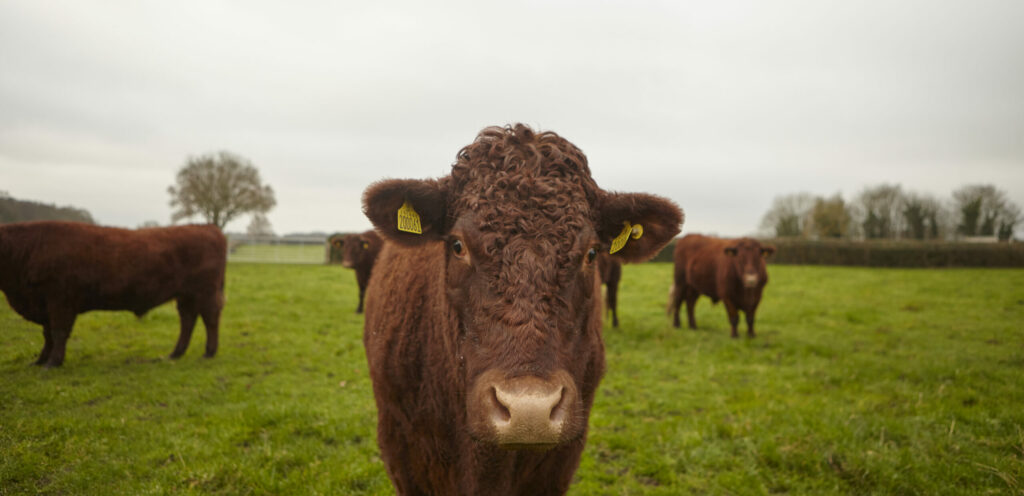
Regenuary:
red meat vs white meat
Bee argues we need more information about the meat we’re eating, too:
“We need to combat the argument that all white meat is better than red meat.
“Ruminant animals can make use of grasslands, a niche that humans can’t utilise. I don’t think there’s any justification for keeping pigs and chickens and feeding them on soya. The role of monogastric animals such as these should be to use food waste, byproducts and surplus crops which are produced as a buffer to prevent shortages.”
This issue is so important to Bee that even though she discovered someone in the next village who produces “delicious” rare-breed pork on a small-scale, she says she’s stopped buying from them because they use soya to feed the pigs.
Veganuary and Regenuary:
the common ground
So, what’s the answer?
Bee goes first:
“The message I would leave people with, is that meat is complicated and there’s no getting around that. We need to eat way less meat and dairy products and we need to grow far, far more fruit and vegetables in this country. And that is going to mean displacement of some livestock farming. We need to be careful that we retain the best animal agriculture, which conserves biodiversity and maintains cultures, and replace the low welfare, industrialised and high emissions/pollution farming .
“My concern is that if all those who are concerned about these issues go vegan, we will lose the best and keep the worst of animal agriculture, because the only people buying meat will be those who don’t care about these issues. For that reason, persuading anyone you know who will carry on eating meat anyway to switch to organic and regeneratively produced meat is a valuable contribution, while reducing how much meat you yourself eat.
Tolly says the answer is pretty simple: “The main message is to eat good food and not rubbish food.”
Veganuary and Regenuary:
how to tell the good from the bad
So, how can you tell the good from the bad?
“There’s so much misinformation out there, it’s difficult for people to get good information,” says Tolly. “If you’re buying organic food, at least someone has done the groundwork for you. As much as I hate the idea of certification, it does make sure people are informed and are actually buying what they think they’re buying.”
Bee went on a recent climate change march and her banner read: “Cool the planet, choose organic”.
“It’s a simple message to convey a complex set of issues,” she says.
“I agree it is good to avoid highly processed food, whether it is vegan, contains animal products, or is organic. The point is we need people to connect more closely with how their food is produced. The more processed it is the greater the distance between the producer and the person eating the food. Buying food direct, or one step removed from the producer, provides more accountability. That is never more important than when buying meat and animal products.”
Underlying the whole vegan/regen debate is the fact that the food system needs a radical overhaul. One thing Tolly and Bee agree on is that buying locally produced food from farmer-focussed supply chains is better than buying from supermarkets.
Farmer-focused supply chains enable the farmer to get a larger share of the sale price. This, in turn, supports better farming practices.
While supermarkets are able to offer convenience and low prices, these same low prices are driving UK farmers out of existence because their margins are so narrow.
The challenge is to find a way to make organic, seasonal fruit and vegetables – and the occasional helping of meat or dairy produce for those who want it – accessible to everyone, while enabling sustainable farmers to generate a livelihood.
MORE ABOUT THE AUTHORS…
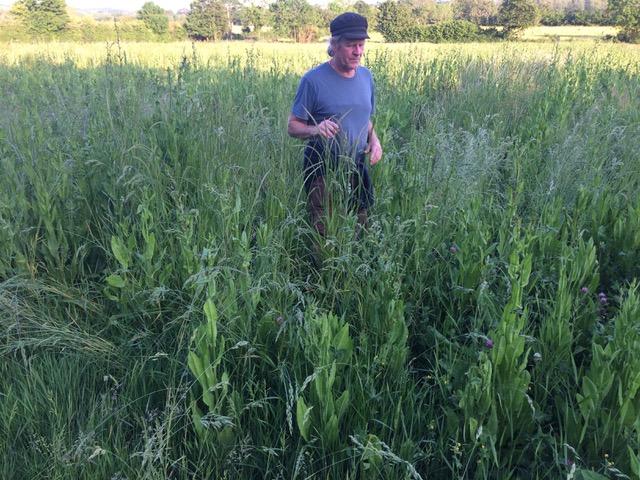
TOLLY: A SHORT BIOGRAPHY (AND FINAL WORDS)
Tolly is a vegetarian who eats a predominantly plant-based diet, which he largely attributes to his introduction to farming, on an intensive dairy farm in the 1970s. He says it opened his eyes in two ways:
“Firstly, to the horrors of modern farming and secondly, the realities of keeping livestock”.
At first, it was a dedication to organic that turned Tolly off using imported manure from other farms. Even the horse manure that is in abundance near their farm in Berkshire is laden with chemicals and pharmaceuticals.
But, he explains, it evolved into an ethical decision around livestock production. And also one about the ethics of land management:
“We’ve been subject to many studies over many years. We’ve been able to show quite clearly we can produce an awful lot of food with a very low carbon footprint. That’s primarily because we don’t import land in the form of compost or manure.”
Tolhurst Farm is on quite low-grade land. But, not being able to import fertility made Tolly look at this from a different perspective. He sees the soil as a huge reserve rather than one full of deficiencies.
As such, Tolly farms in the way that builds a soil’s “inherent” fertility. He maintains he releases the nutrients that already exist within it.
“The issue is not so much as one about veganism for me, but about the practicalities of farming,” he says.
“We have 13 million worms per hectare so we’re not livestock free at all. Technically, we have more organisms than any other farm in the country.”
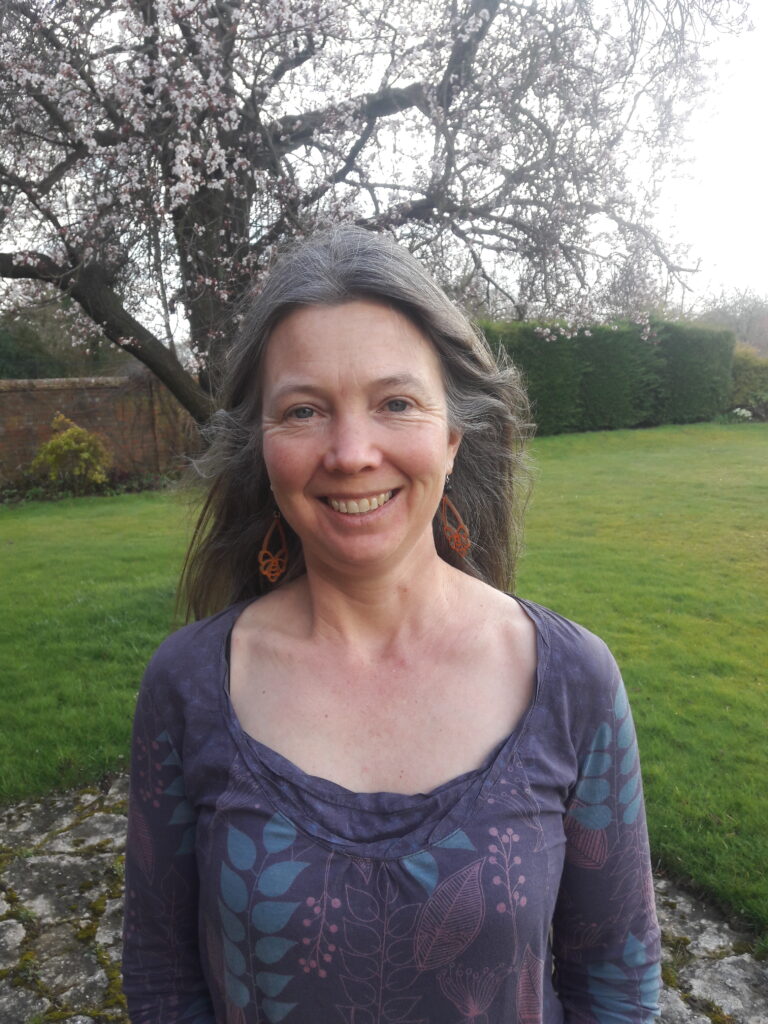
BEE: A SHORT BIOGRAPHY (AND FINAL WORDS)
Bee currently works in a glasshouse growing vegetables and herbs. It’s a vegan glasshouse. To the degree to which they catch the rats and mice to transport them elsewhere rather than kill them.
But, Bee’s time at Tamarisk Farm was one of the most influential in terms of forming her views.
She explains:
“I’m absolutely in favour of eating a lot (lot lot) less meat. At Tamarisk all the fertility comes either from a mixture of leguminous green manures; or manure from the cattle, who have calved in an open barn; and sheep, some of which are overwintered in the polytunnels, to prevent poaching during the wet months of January and February. The biodiversity is simply astonishing. In any one place in the fields, you are likely to find more than 30 species if you threw down a 1m2 quadrant.
“The sheep and cattle have a really important role in maintaining that diversity. They graze the grassland and keep the land open, so diverse plants can continue to thrive. This diversity is across many acres of grassland, rather than just around the margins of cultivated fields. It provides abundant habitat for insects, birds and mammals.
“We cut the hay meadows each year, to provide winter forage for the livestock. According to Plantlife, wildflower meadows (created by annual cutting and removal of hay) are botanically richer than any other habitat. Yet 97% of wildflower meadows have been lost since the 1930s.”
Originally published in 2022


